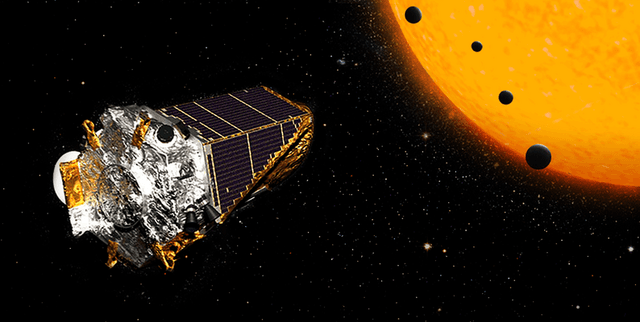Kepler Mission Exoplanet Catalogue
Space & Astronomy
Tags and Keywords
Trusted By




"No reviews yet"
Free
About
This dataset contains detailed information on approximately 3,373 confirmed exoplanets discovered by the Kepler Telescope, including those found during Kepler's K2 mission. The Kepler Mission's primary goal is to explore the structure and variety of planetary systems by surveying a large sample of stars. This dataset is designed to support the scientific objectives of the Kepler Mission and future NASA missions by providing extensive data on these discovered exoplanets.
Columns
The dataset includes 67 columns with detailed information on exoplanets and their host stars:
- rowid: Row identifier.
- pl_hostname: Name of the host star.
- pl_letter: Designation letter of the planet.
- pl_discmethod: Method used to discover the planet.
- pl_pnum: Number of planets in the system.
- pl_orbper: Orbital period in days.
- pl_orbpererr1: Upper uncertainty of the orbital period [days].
- pl_orbpererr2: Lower uncertainty of the orbital period [days].
- pl_orbperlim: Orbital period limit flag.
- pl_orbsmax: Semi-major axis of the orbit [AU].
- pl_orbsmaxerr1: Upper uncertainty of the semi-major axis [AU].
- pl_orbsmaxerr2: Lower uncertainty of the semi-major axis [AU].
- pl_orbsmaxlim: Semi-major axis limit flag.
- pl_orbeccen: Orbital eccentricity.
- pl_orbeccenerr1: Upper uncertainty of the eccentricity.
- pl_orbeccenerr2: Lower uncertainty of the eccentricity.
- pl_orbeccenlim: Eccentricity limit flag.
- pl_orbincl: Orbital inclination [degrees].
- pl_orbinclerr1: Upper uncertainty of the inclination [degrees].
- pl_orbinclerr2: Lower uncertainty of the inclination [degrees].
- pl_orbincllim: Inclination limit flag.
- pl_bmassj: Planet mass or M*sin(i) [Jupiter masses].
- pl_bmassjerr1: Upper uncertainty of the planet mass [Jupiter masses].
- pl_bmassjerr2: Lower uncertainty of the planet mass [Jupiter masses].
- pl_bmassjlim: Planet mass limit flag.
- pl_bmassprov: Provenance of the planet mass data.
- pl_radj: Planet radius [Jupiter radii].
- pl_radjerr1: Upper uncertainty of the planet radius [Jupiter radii].
- pl_radjerr2: Lower uncertainty of the planet radius [Jupiter radii].
- pl_radjlim: Planet radius limit flag.
- pl_dens: Planet density [g/cm³].
- pl_denserr1: Upper uncertainty of the planet density [g/cm³].
- pl_denserr2: Lower uncertainty of the planet density [g/cm³].
- pl_denslim: Planet density limit flag.
- pl_ttvflag: Transit Timing Variation flag.
- pl_kepflag: Kepler field flag.
- pl_k2flag: K2 mission flag.
- pl_nnotes: Number of notes.
- ra_str: Right Ascension in sexagesimal format.
- ra: Right Ascension in sexagesimal format.
- dec_str: Declination in sexagesimal format.
- dec: Declination in sexagesimal format.
- st_dist: Distance to the star [parsecs].
- st_disterr1: Upper uncertainty of the distance [parsecs].
- st_disterr2: Lower uncertainty of the distance [parsecs].
- st_distlim: Distance limit flag.
- st_optmag: Optical magnitude.
- st_optmagerr: Optical magnitude uncertainty.
- st_optmaglim: Optical magnitude limit flag.
- st_optmagblend: Optical magnitude blend flag.
- st_optband: Optical magnitude band.
- st_teff: Effective temperature of the star [K].
- st_tefferr1: Upper uncertainty of the effective temperature [K].
- st_tefferr2: Lower uncertainty of the effective temperature [K].
- st_tefflim: Effective temperature limit flag.
- st_teffblend: Effective temperature blend flag.
- st_mass: Stellar mass [solar masses].
- st_masserr1: Upper uncertainty of the stellar mass [solar masses].
- st_masserr2: Lower uncertainty of the stellar mass [solar masses].
- st_masslim: Stellar mass limit flag.
- st_massblend: Stellar mass blend flag.
- st_rad: Stellar radius [solar radii].
- st_raderr1: Upper uncertainty of the stellar radius [solar radii].
- st_raderr2: Lower uncertainty of the stellar radius [solar radii].
- st_radlim: Stellar radius limit flag.
- st_radblend: Stellar radius blend flag.
- rowupdate: Date of the last update.
Distribution
This dataset is provided as a CSV file named
planets.csv, with a size of 1.01 MB. It contains approximately 3,372 records detailing confirmed exoplanets. The data structure includes 67 distinct columns, providing extensive detail for each record.Usage
This dataset is highly suitable for:
- Astrophysical Research: Facilitating studies on planetary formation, system dynamics, and the potential for habitability.
- Educational Purposes: Serving as a rich resource for educational programmes and projects related to space science.
- Data Analysis and Visualization: Providing data for analysis and visualization of exoplanet characteristics and their distributions.
- Public Outreach: Enhancing public understanding and interest in exoplanetary discoveries and space exploration.
Coverage
The dataset covers confirmed exoplanets discovered by the Kepler Telescope, including its K2 mission. The data spans multiple years of the Kepler and K2 missions, with record updates observed between 14th May 2014 and 12th August 2016. Geographic scope is not applicable, as the data pertains to celestial bodies beyond Earth's solar system, with celestial coordinates (Right Ascension and Declination) provided for the host stars.
License
CC BY-SA 4.0
Who Can Use It
- Astrophysicists and Planetary Scientists: For in-depth research into exoplanet properties and planetary system evolution.
- Educators and Students: For teaching and learning about space science, astronomy, and data analysis.
- Data Scientists and Analysts: For developing models, visualisations, and insights into astronomical data.
- Science Communicators: For creating engaging content to inform and inspire the general public about space exploration.
Dataset Name Suggestions
- Kepler Exoplanet Discoveries
- Confirmed Kepler Planets Archive
- Exoplanet Data by Kepler & K2
- Kepler Mission Exoplanet Catalogue
Attributes
Original Data Source: Kepler Mission Exoplanet Catalogue
Loading...
Free
Download Dataset in CSV Format
Recommended Datasets
Loading recommendations...
